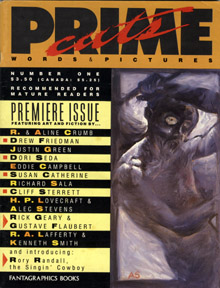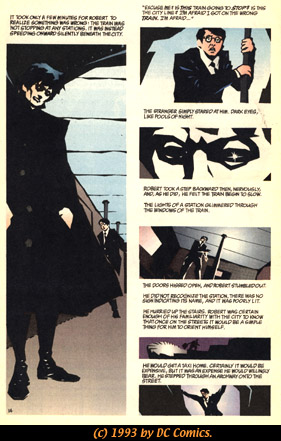
|

|

Alec Stevens began his first professional comics work at age twenty in the summer of 1985, being an adaptation of Oscar Wilde's
short story, "The Sphinx Without a Secret". This and several other literary interpretations were purchased by Gary
Groth, publisher of Fantagraphics books, the following year. Alec attempted to infuse a fine art sensibility into these stories,
experimenting in the Wilde story with "something akin to French Impressionism, but in black and white", according
to the artist, and German Expressionism and Art Nouveau in subsequent stories. He adapted short works by Russian authors Leonid
Andreyev and Leo Tolstoy which Fantagraphics never published. "These were by far the best I'd done for them," he
states, "the former being pen-and-ink and watercolor, again in Expressionist mode but with tinges of Italian Futurism",
and the latter being in oils on canvases. "I painted the Tolstoy story in 1987, and Groth had them hanging up in his
offices for a year. He remarked that Gil Kane was taken aback, saying, 'Whoever did these made a herculean effort', and likewise
the Hernandez (Love and Rockets) brothers expressed much appreciation. I did figure studies from life (no photos) for every
panel, and painted it, making a few nods to Edvard Munch and Gustav Klimt along the way."

Next Alec set out to adapt Fyodor Dostoyevsky's "Notes from Underground" into a 48 page graphic novel. "In
1988 I had heard that DC was embarking on publishing 'mature readers' (non super-hero) comics under the Piranha Press imprint.
But DC's execs made it clear that they wanted original material, so in a week's time I wrote the script for what would become
my first graphic novel, THE SINNERS. It was widely hailed in various magazines and newspapers across the U.S. and U.K., but
strong sales never materialized, partly because they were not available in regular bookstores, only comic shops."
At this time Alec was a regular visitor to veteran comics artist Bernie Krigstein's studio
whose "Master Race" from 1955 is perhaps the most influential and highly regarded comic book story in the western world. "Krigstein
had turned his back on comics, doing commercial illustration and eventually settling into teaching and fine art, but it was
perhaps he who had most influenced me to attempt to 'elevate' the (comics) form in his prior work."
In 1989 he followed
up THE SINNERS with HARDCORE, a morality tale with a brutal, uncompromising eye that was contained some of his most cinematic
sequences up till that time. "I was the prodigal son at the height of his decadence when I created that," Alec says. "I'm
not surprised that everything in my life came tumbling down, beginning the very day I finished that. It's the darkest, most
disturbing work I've done. " In the midst of illustrating HARDCORE Alec paused to write and draw the haunting and somewhat
existential "Rising Hill" for FAST FORWARD #1, a little seen anthology published by Piranha Press.
Physically and
emotionally shattered by events touched upon in the 'Spiritual Biography' section, he drew no comics stories in 1990, save
a three page adaptation of Fyodor Dostoyevsky's "The Onion" for the January 1991 issue of HEAVY METAL magazine. "I had just
surrendered my life to Jesus Christ, and wanted to do something that reflected that. In retrospect, this story is very 'religious'
but is doctrinally amiss. Still, it's a wonder that HM saw fit to print it."
In 1991 Alec sold a 24 page story aptly entitled "Silence" to Dark Horse Comics which
ran in six issue installments of DEADLINE: USA. "It, too, was a spiritual allegory, well-intentioned, but again, somewhat
wrong-headed. I was a baby Christian, and still very worldly in many respects." In 1992 he drew his last two literary
adaptations which appeared some years later in TABOO #8 and 9 by Kitchen Sink Press.
Says he, "In 1992 an agency
handling the art direction for AT&T's MICROSCOPE, a journal for its then-118,000 employees, commissioned me to do editorial
illustrations, but once I drew some comics sequences for them, they were such a hit that I was asked to do a subsequent page
or two which ran on the front cover, even ousting the cover logo to page two!"
In the fall of 1992 Alec began
a tenure as an instructor at the Joe Kubert School of Cartoon and Graphic Art which continues to this day. "It is gratifying
to have had a directing hand in the lives of numerous former students who are now today's industry professionals
(Steve Lieber, Sergio Cariello, Damien Scott, and Alex Maleev, amongst many others)."

Making a rare appearance at a NYC comics convention in March, 1993, Alec had a chance encounter
with Neil Gaiman: "Neil turned out to be a fan of my earlier work, and asked that I draw an issue of SANDMAN. I didn't really
know anything about the character, and agreed. Had I known how occultic the series was, I probably would have declined. As
it was, my story was rather innocuous, somewhat like an old 'Outer Limits' episode." This would see print as the 16 page
centerpiece of SANDMAN #51, reprinted as the lead story in the WORLD'S END collection. "Over 110,000 copies of that issue
sold in the first two weeks, and at the next convention I attended, people lined up continuously in droves for autographs
all day long. Vertigo editor-in-chief Karen Berger once wrote to me, '...This is one of my all-time favorite SANDMAN
stories.'"
From 1993-1999 Alec contributed artwork to DC's Paradox Press (formerly Piranha Press) imprint. These were short stories
that appeared in their 'factoid' comic book anthology series, THE BIG BOOK OF... (URBAN LEGENDS, WEIRDOS, DEATH, etc.).

Approached by Tower Records' PULSE! magazine editor, Alec drew editorial illustrations and occasional comics pages for them
from 1994-1999. In 1995 he was asked by Sam Kieth to draw a MAXX trading card "which was probably as close to drawing
a mainstream super-hero as I've come". In 1997 he drew a cover for Acclaim's Classics Illustrated line. Says he, "These
were reprints of the 1950s CLASSICS ILLUSTRATED comics in paperback form, recolored and with 'scholarly notes' added at the
end. Mine was for Bret Harte's THE OUTCASTS OF POKER FLAT. I was paid, but it never saw print. Acclaim ceased publication
shortly thereafter."

His last story for secular comics appeared in 1999 in Paradox Press' THE BIG BOOK OF GRIMM.
"It was a three pager entitled 'Clever Else'. I had heard a similar children's story known as 'The Three Big Sillies'.
Appropriately, this was the closing story in the book. I don't know if I shall have any involvement in secular comics
from this point on. Unlike some who've left the field, I have no bitterness. But given a choice, I'd rather work
on material that openly glorifies the Lord Jesus Christ."
Alec Stevens' Christian comics work includes
a short story in the PROVERBS & PARABLES anthology, the publication of GLORY TO GOD #1 and 2, and a fifteen page comics
tract for "Unshackled!", the long-running Christian radio show aired internationally by Moody Bible Broadcast. To see
samples of these, click on the "Christian Comics" link at the top of this page.
|

|

|

